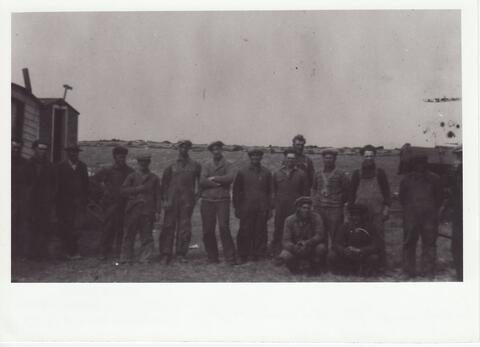
Title and statement of responsibility area
Titel
Relief Camp #28, Shamrock, Saskatchewan
Algemene aanduiding van het materiaal
- Graphic material
Parallelle titel
Overige titelinformatie
Title statements of responsibility
Titel aantekeningen
- Parallel titles and other title information: Historic Photos - Miscellaneous - 1850 - 1930s - Relief Project #28
Beschrijvingsniveau
Stuk
archiefbewaarplaats
referentie code
Editie
Editie
Edition statement of responsibility
Class of material specific details area
Statement of scale (cartographic)
Statement of projection (cartographic)
Statement of coordinates (cartographic)
Statement of scale (architectural)
Issuing jurisdiction and denomination (philatelic)
Datering archiefvorming
Datum(s)
-
September, 1933 (Vervaardig)
- Plaats
- Shamrock (Sask.)
Fysieke beschrijving
Fysieke beschrijving
1 photograph: b&w
Publisher's series area
Title proper of publisher's series
Parallel titles of publisher's series
Other title information of publisher's series
Statement of responsibility relating to publisher's series
Numbering within publisher's series
Note on publisher's series
Archivistische beschrijving
Geschiedenis beheer
Bereik en inhoud
The men of Relief Camp #28, Shamrock, Saskatchewan are pictured standing beside ramshackle buildings on open prairie; the men of Relief Camp # 28 worked as a highway construction crew.
Aantekeningen
Materiële staat
Directe bron van verwerving
Ordening
Taal van het materiaal
Schrift van het materiaal
Plaats van originelen
Provincial Archives of Saskatchewan - RA7632(1)
Beschikbaarheid in andere opslagformaten
Restrictions on access
Termen voor gebruik, reproductie en publicatie.
Copyright: Public Domain
Toegangen
Associated materials
Aanvullingen
Algemene aantekening
The Great Depression brought high unemployment rates for most areas across Canada with many industries able to pick and choose which workers they wanted to keep and which they could let go, knowing that there would be plenty of new workers lining up to take any available spots. Employers could institute a paycut and unless a worker was willing to join the jobless with little chance of getting another job, they would have to accept the cut. Unions and government could do very little about the situation.
Many local communities and Provincial governments set up a system of relief which was a payment ranging from $19 in the Maritimes to about $60 in Alberta which went to families who desperately needed help to get by. Single unmarried men were not eligible. Most of the payment was in the form of vouchers which could be exchanged for food and clothing.
By October 1932, the Federal government was finally ready to do something about the unemployment catastrophe among men which averaged about 30% nationwide but reached almost 40% in some regions. The army chief of staff, Major General McNaughton had studied some of the ideas and programs that were taking shape on Roosevelt and the New Deal in the United States and recommended to Prime Minster Bennett that a program could be setup whereby, young unemployed men would be provided, shelter, food, and a minimum payment in exchange for living in a semi-military type of camp and working on various projects.
The men were paid 20 cents a day and were required to work 44 hours a week. They were set to work replanting trees in heavily logged areas, building roads and bridges throughout the west, working on construction projects to erect public buildings, and within the camp there was a requirement for various trades and professions such as carpenters, metal workers, accountants, farmers and many others.
The trade unions began to gain some influence in the camps as they worked to convince the men that the 20 cents a day they were earning was not fair and hat they needed to take some sort of action to force an increase in wages. By April of 1935, resentment reached a boiling point and many of the relief camps in B.C. went on strike which resulted in the consolidation of the action in Vancouver and a decision to march on Ottawa to demand fairer action for the men. The action ended in Regina in July when a violent confrontation broke out with between local police and the relief camp workers, One constable died and many police and workers were injured.
The relief camps continued to operate and, the Regina Riot aside, when the were closed down in 1936, they had seen over 170,000 men come through the camp gates and helped get the country up and running again.
Location note
Box # 4

